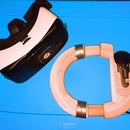Introduction: 360 Degree Photospheres
A new way to capture a moment from top to bottom. Google's camera app on android gives an easy was to stitch together dozens of photos to create a 180 degree x 360 degree panorama or Photosphere. Google has recently release a photosphere app for iphones, so iOS users can now get in on the action also, but this instructable will focus on the android version. View the cover photo as a photosphere HERE. If you're on a mobile device, open with the Google+ app. The photo should begin to rotate on its own, but you can look left, right up or down using your mouse or by swiping the screen on your mobile device.
If you like this instructable, please consider voting for me in the Photography Tips and Tricks contest. Enjoy.
Step 1: How to Capture a Photosphere
All of these apps work basically the same. The camera view will have a target dot. When you align the center on the target one photo will be captured. The target dot is then moved up, down, left or right of the first photo. I have found moving to the right to works best. You will take a shot every 30 degrees or so. 20+ photos to make a single photosphere. Once all targets have been shot, the app will automatically begin processing all the images into a distorted 180 x 360 equi-rectangular image.
You've done it! But now you'll want a 180 x 360 pan and tilt camera mount for your tripod, so you can get repeatably seamless photospheres every time.
Step 2: Making a Pan and Tilt Camera Mount
To make mine I bought an inexpensive phone tripod and discarded the telescoping legs. Well I removed the legs and stashed them away, I don't discard anything. This provided an adjustable clamp to hold the phone securley, provided easy adjustment up and down. Then I just had to take two L brackets I had laying around and drill wholes so I could make adjustment left to right to center the lens over the tripod swivel axis. The bolt connecting the two L brackets acts as the up/down axis. This will provide much better results than taking the images by hand.
Step 3: How to View Your Photospheres
If you're using a Samsung device and you took the photo using the phones default camera, in surround shot mode, than you can view the finished surround shot using the phone's default photo gallery. If you used the Google camera app than you can use the Google Photos app to view your photosphere. Both option have an auto rotate or play mode that will rotate the photo from left to right. You can also swipe the picture with your finger to look up, down, left and right. The last mode is the compass mode. Look for a navigation symbol, when you press it the photo will respond to movement. This feature allows you to naturally, look around.
Step 4: Now View Your Photospheres in VR
If you have a Samsung Galaxy S6 or Note 4 than the Samsung Gear, powered by Oculus, is a must have. Check it out HERE. With the Gear headset you can view your Samsung Surround Shot photos in an app called "Oculus 360 Photos".
If you don't have a Samsung device or your on a tight budget than the Google Cardboard or Open Dive headsets might be for you. You can see more about both the Cardboard and Open Dive headsets on my website DivideWorks.com Both headsets will work with the Google Cardboard Demo App, which includes a photosphere viewer. This will show your image in a side by side format and will automatically respond to your movement. By far the best way to experience these images, VR headsets combined with a photosphere create a fully immersive experience, allowing you to share the moment putting people right in the center of the action.
If you have a VR headset I would also recommend checking out 360 degree video. Putting a new perspective on entertainment.
Step 5: How to Share Your Photospheres
Another cool way to share your photospheres publicly is to upload them onto Google Maps. This will be added along with the street view for the location the photo was taken from. HERE is an example.
See more info at http://www.google.com/maps/about/contribute/photos...
Step 6: Get Creative
Since the photosphere is made up of many separate photos you can have you're subjects appear multiple times in the finished sphere. I have found that if you move from left to right, than even though your second shot may overlap, where your subject was in the first shot but is missing from the second shot, the finished photosphere will keep the image of your subject from the first shot. Use this LINK to view this photo on Google+






